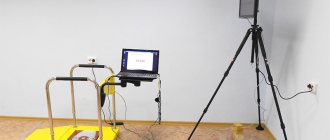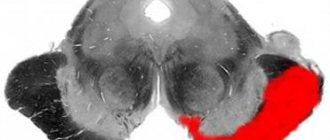Causes of headaches and tinnitus
It is important to determine the cause of the headache. If it is accompanied by noise, there are two types of it: objective and subjective. The first option is the one that is heard not only by the patient, but also by the doctor during the examination. It can be created by blood vessels, the muscles of the middle ear, the auditory tube, and also appear due to improper functioning of the temporomandibular joint. Subjective noise is heard only by humans; it is not detected during examination.
Diseases of the ENT organs
One of the common reasons for headaches and tinnitus is diseases of the ENT organs. They can occur due to hypothermia, exposure to viral and bacterial infections, as well as due to injuries and congenital abnormalities of the structure of organs. As a result of diagnosis, various diseases can be detected that require an individual approach to treatment.
- Otitis is an inflammation of the ear. The disease is accompanied by pain in the head and ear, as well as noise and buzzing in the ears, and hearing impairment. In the initial stages, symptoms may be nonspecific and include only hearing impairment and noise in the head. Otitis media is the most dangerous, since the inflammatory process can spread to the membranes of the brain. Another characteristic symptom is the appearance of discharge from the auditory canals.
- Blockage of the auditory canals is accompanied by hearing impairment, headaches, noise and deterioration of well-being. It can be caused by cerumen plugs, which appear as a result of improper ear hygiene or increased sulfur production. Also, during diagnosis, foreign objects may be detected in the ear canals.
- Meniere's disease is a specific disease in which the amount of fluid in the labyrinth of the ear increases. This organ is located in the inner ear and not only performs the auditory function, but is also responsible for balance. If the volume of free fluid exceeds the norm, the patient experiences headaches, tinnitus, dizziness, nausea and other symptoms.
- Neoplasms are detected as a result of a comprehensive diagnosis of ENT organs. Their danger is determined by their type and size, and the need for surgery is determined by the doctor.
Diseases of the ear and ENT organs require timely diagnosis and treatment. If they progress, there is a possibility of infection or inflammation spreading to neighboring structures, including the lining of the brain.
Vascular diseases
Tinnitus is often associated with pathologies of the vascular system. It is caused by improper blood circulation through the arteries, which can cause oxygen starvation of brain cells. This causes dizziness, tinnitus, a sharp deterioration in health, and over time can also provoke a stroke.
During diagnosis, the following disorders may be detected:
- atherosclerosis (main article: Headache as a symptom of atherosclerosis) is a disease that is manifested by the deposition of cholesterol and some fractions of lipoproteins on the inner walls of blood vessels, the formation of plaques and blood clots;
- hypertension (main article: Headache in hypertension) is a chronic disease in which there is a frequent increase in blood pressure, which over time leads to stretching of arterial walls, slowing blood circulation and deteriorating oxygen supply to brain cells;
- stenosis (narrowing) of the lumen of the vertebral and carotid arteries, which directly provide blood supply to the brain.
If you suspect vascular disease, it is important to undergo examination by a cardiologist. These disorders can be caused by heart pathologies, congenital or acquired defects. For chronic diseases of the cardiovascular system, it is important to periodically contact a specialist for routine examinations.
Diseases of the cervical spine
Main article: Headache with cervical osteochondrosis
The cervical spine contains important vessels that carry blood to the brain. Normally, they pass through holes in the vertebrae, thereby being protected from mechanical damage. However, in a number of diseases, arteries are compressed by surrounding tissues, and oxygen access to brain cells is impaired. As a result of a comprehensive examination, the following disorders can be diagnosed:
- osteochondrosis is a chronic disease in which slow destruction of the tissues of the vertebrae and intervertebral discs occurs, as well as compression of the arteries and spinal nerve roots;
- intervertebral protrusions and hernias - pathological protrusion of cartilage, which leads to acute pain, limited mobility of the upper limbs, as well as tinnitus, hearing impairment and other symptoms;
- injuries and their consequences - with improper rehabilitation, as well as in the presence of serious injuries, symptoms may appear after a long time.
Treatment of diseases of the cervical spine depends on their type and stage. Your doctor may prescribe exercises to do at home, painkillers, anti-inflammatory medications, and muscle relaxants. However, some diseases may require surgery - it is prescribed for large hernias, comminuted fractures and other pathologies.
Migraine
Migraine is a primary headache. It is not caused by pathologies of any organs, and its origin is associated with vascular or nervous factors. There are several stages in the development of migraine, one of which is aura. In most patients, it appears several hours before a headache attack and includes the following symptoms:
- dizziness, tinnitus, auditory hallucinations;
- blurred vision, lacrimation, exacerbation of reaction to bright light;
- nausea, sudden deterioration in health;
- mood swings.
Migraine may first appear in both childhood and adulthood. Its attacks occur with a certain frequency and may be associated with changes in weather conditions or atmospheric pressure, or moving to a different climate zone. In addition, migraines can manifest themselves against the background of stress, nervous tension, and disruption of sleep schedules.
Other reasons
Headache and tinnitus are typical manifestations of many conditions. When they appear, it is important to undergo a full examination, since they can indicate both minor disorders and dangerous pathologies. Thus, as a result of diagnostics, the following changes may be detected:
- hypoglycemia – a decrease in blood glucose levels, which is typical for diabetes mellitus;
- intense physical activity without sufficient rest, which leads to deterioration of blood supply to the brain (main article: Headaches during exercise);
- inflammatory diseases, thyroid neoplasms;
- pathology of the temporomandibular joint.
A similar symptom complex can develop with prolonged use of certain medications. These include steroidal anti-inflammatory drugs and chemotherapy drugs. If headaches and tinnitus go away with rest, they do not indicate serious pathologies.
general characteristics
Auditory hallucinations are manifested by various sound phenomena - melodies, noises, voices, which are perceived by patients as true, really existing.
The attitude towards hallucinatory phenomena as a pathology is formed gradually as a result of beliefs on the part of loved ones and doctors. In mental disorders, when hallucinatory sounds are justified by delusional concepts, patients continue to believe in the reality of what they hear, despite the assurances of others. Auditory hallucinations can be simple or complex. Simple ones are represented by acoasms - noise, hissing, roaring, grinding, buzzing. Sometimes patients cannot guess what type of source generates the sound, in other cases they clearly determine its “reasons” - the shuffling of a boot sole, the creaking of floorboards, the hum of a car. Another type of simple auditory hallucination is phonemes. These are speech deceptions of hearing in the form of shouts, individual vowel sounds, syllables, and fragments of words.
Complex auditory hallucinations are represented by musical and verbal images. With musical phenomena, people hear playing musical instruments, singing, and melodies. Verbal hallucinations – individual words, phrases, monologue or dialogic speech. Verbal hallucinatory phenomena include commentary, threatening and imperative. Commenting voices express an opinion about the patient’s actions, threatening voices intimidate, imperative voices order or prohibit something to be done, for example, they demand to commit suicide or refuse to eat.
Diagnostic methods
Timely diagnosis is the main condition for successful treatment of diseases that are accompanied by headaches and tinnitus. After the examination, the doctor will prescribe additional examinations that will determine the main cause of the deterioration in health. So, the following diagnostic methods may be needed:
- measuring blood pressure, including monitoring this indicator throughout the day;
- blood tests - general and biochemical, as well as determination of glucose and cholesterol levels;
- angiography of cerebral vessels - allows you to determine the intensity of blood circulation, the presence of spasms and blockage of the arteries;
- computer or magnetic resonance imaging is the main method for detecting tumors, aneurysms and other pathologies that require surgical treatment, as well as diseases of the cervical spine.
The Clinical Brain Institute houses precise, modern equipment for diagnosing a number of diseases. Experienced doctors will prescribe only the necessary examinations, which will allow you to quickly make an accurate diagnosis and begin treatment. It is important that it is impossible to obtain all the necessary information about the stage of the disease and its causes either at home or on the basis of a simple examination.
Which doctor treats
Since noise in the head is a symptom of ear diseases, as well as neurological pathologies, if an unpleasant symptom appears, you should contact an otolaryngologist or neurologist.
Why suffer from noise in your head if you can turn to a specialist at the Kuntsevo Medical and Rehabilitation Center to solve the problem?
IMPORTANT! You should not self-medicate, because noise in the head is a neurological symptom that may indicate the development of serious pathologies.
Our neurologist and otolaryngologist will conduct a detailed study of the causes of the symptom and indicate a direct path to solving the problem and getting rid of noise in the head. You just need to make an appointment with our doctor, who will not only help you get rid of the symptom, but will also describe a detailed course of rehabilitation.
Sign up
Treatment of headaches and tinnitus
To treat headaches, the doctor prescribes a regimen, which may include conservative methods or surgical intervention. For acute pain, you can take painkillers, but they will not affect the underlying cause. For different diseases, the following methods may be required:
- for hypertension - blood pressure correction agents, diuretics, medications to support heart function;
- for diseases of the cervical spine - therapeutic exercises, painkillers and muscle relaxants;
- specific treatment of ENT organs;
- diet for high cholesterol levels, diabetes mellitus;
- drugs for the treatment of migraine.
If possible, the doctor will prescribe medications to take at home. However, if surgery is necessary, it is recommended that the operation be performed as scheduled. The effectiveness of treatment depends on a well-chosen regimen, as well as on following all recommendations at home: diet, exercise, and others.
Prevention methods
Timely prevention will help avoid headaches and tinnitus. Doctors at the Clinical Brain Institute recommend following the following recommendations:
- avoid stress and nervous tension;
- normalize your sleep and rest schedule;
- engage in regular physical exercise, including outdoor exercise;
- follow a diet that contains vitamins and microelements in sufficient quantities, as well as a minimum of fatty and fried foods;
- give up bad habits, smoking and drinking alcohol - they affect the condition of blood vessels.
At the Clinical Brain Institute, you can undergo a complete diagnosis and treatment of headaches that are accompanied by tinnitus. Our center has modern equipment. Its use allows you to get an accurate result in the shortest possible time, and then begin treatment of the underlying disease. Doctors warn that the effectiveness of treatment largely depends on compliance with all instructions at home, taking prescribed medications and following other instructions.
Clinical Brain Institute Rating: 5/5 — 1 votes
Share article on social networks










